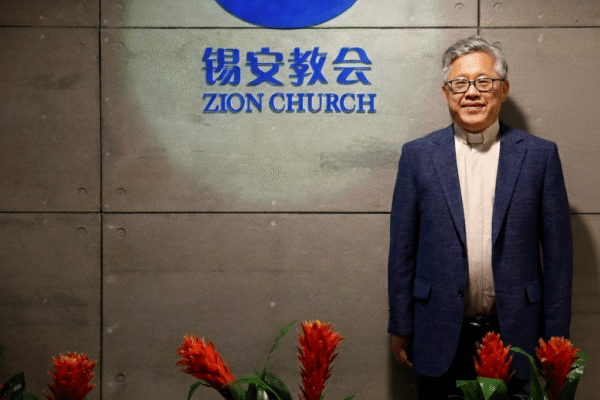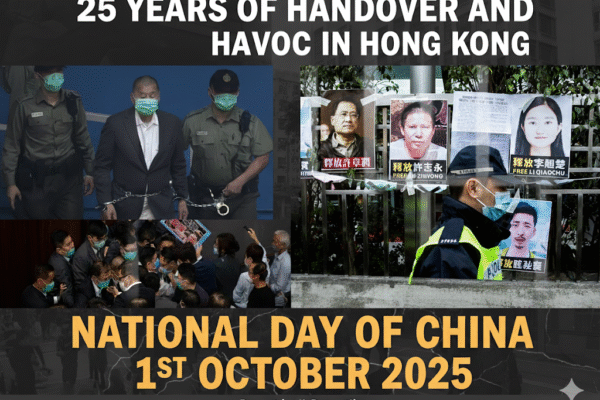
Category: East Asia
South Korea issues travel ban after nationals trapped in Cambodia scam centers
RFA Perspectives — South Korea issued a “code-black” travel ban for parts of Cambodia on Oct. 15 and dispatched a team of high-level officials to help nationals lured into working in scam compounds and secure the release of those held against their will, according to the Reuters news agency. More than 1,000 South Koreans are believed to be among about 200,000 people of various nationalities involved in the scam compounds in Cambodia, South Korea’s National Security Adviser Wi Sung-lac told reporters. Video: Why Cambodia and Southeast Asia became a scam havenRFA Korean’s Jaewoo Park reports for RFA Perspectives: Why has Southeast Asia — especially Cambodia and Myanmar — become a “scam haven”? It’s not just about crime. It’s the result of corruption, lawlessness, and economic desperation. Across the region, hundreds of thousands of people are trapped inside cyber scam compounds. They are lured by fake job ads, kidnapped, and forced to commit online fraud under brutal conditions. Earlier this year, Chinese actor Wang Xing made international headlines after being rescued from Myanmar’s notorious KK Park. He had flown to Thailand for an acting job — but was kidnapped and sold into a scam operation. His rescue was extremely rare. In August, a South Korean college student was tortured to death in Cambodia after being deceived by a fake job offer. The case shocked the Korean public — but it’s only one part of a much larger criminal network. Recently released footage even showed a man believed to be that student, forced to inhale drugs and explain to his captors how he ended up in Cambodia. So why Cambodia, Laos and Myanmar? Because they sit where lawlessness and capital meet. A decade ago, Cambodia became an early hotspot for Chinese and Taiwanese phone scams, thanks to cheap internet and loose regulations. When China banned online gambling in 2019, those same networks didn’t vanish — they simply moved their operations to Cambodia’s casinos. Special Economic Zones (SEZs) in countries like Laos have become hotbeds of criminal activity due to lax regulations, while in Myanmar, a coup and civil war have made enforcement virtually impossible Add corrupt officials, weak law enforcement, and accessible internet, and you get a perfect breeding ground for organized crime. The United Nations estimates that over 100,000 people have been trafficked into Cambodia for cyber scam operations — victims from China, Korea, Kenya, and across the world. As crackdowns intensify in Myanmar and Laos, more of these criminal networks are shifting into Cambodia. This isn’t just about online scams. It’s a new form of human trafficking — hidden behind a screen. We are : Investigative Journalism Reportika Investigative Reports Daily Reports Interviews Surveys Reportika
US, UK sanction Cambodian conglomerate, alleging role in scam networks
The U.S. and British governments on Tuesday announced a sweeping crackdown on cyber-scam networks in Southeast Asia accused of luring workers with fraudulent job ads or fake romantic relationships, forcing them to extract billions from people across the world through a range of deceptions, then laundering the money they received. The U.S. Treasury Department said it had targeted 146 people in the Prince Group, a multibillion-dollar Cambodian conglomerate, including its 38-year-old leader Chen Zhi. “The rapid rise of transnational fraud has cost American citizens billions of dollars, with life savings wiped out in minutes,” U.S. Treasury Secretary Scott Bessent said in a statement. U.S. citizens lost $10 billion to Southeast Asian scammers in 2024 alone, the statement said. Chen was charged with wire fraud conspiracy and money laundering in an indictment unsealed Tuesday in a federal court in Brooklyn. The U.S. seized around $15 billion in bitcoin allegedly used in money laundering operations. In a statement, the U.S. Justice Department called the move its largest-ever forfeiture action. British officials say they have frozen Prince Group assets that include a mansion, an office building and other properties in London, with a goal of “locking Chen and his network out of the UK’s financial system,” the U.K.’s foreign office said in a statement. “The masterminds behind these horrific scam centres are ruining the lives of vulnerable people and buying up London homes to store their money,” U.K. Foreign Secretary Yvette Cooper said. An email sent to the Prince Group’s press inbox requesting comment was returned as undeliverable. An RFA investigation last year detailed allegations of brutal treatment of workers at the Golden Fortune Science and Technology Park, a Prince Group-linked compound in Chrey Thom, a border town in southeast Cambodia. Employees and former employees described workers enticed with promises of high-paying jobs who were allegedly confined and beaten if they underperformed or tried to escape. RFA reporters charted the rise of Chen from his emigration from China to Cambodia, his founding of the Prince Group in 2015, its role in growing the coastal city of Sihanoukville into a haven for Chinese casinos, its deepening political connections and allegations of criminality. The investigation also found that Prince Group moved millions of dollars around the world in a way that experts said bears hallmarks of money laundering. Golden Fortune Resorts World is among the companies that were impacted by the U.S. and U.K. sanctions Tuesday. Also impacted were the Jin Bei Group, an entertainment and hospitality business that owns a casino in Sihanoukville and is alleged to also operate scam centers, and Byex Exchange, a cryptocurrency platform. Includes reporting from Reuters. We are : Investigative Journalism Reportika Investigative Reports Daily Reports Interviews Surveys Reportika

China Arrests Founder of Prominent Underground Church in Multi-City Crackdown
Chinese authorities have detained Zion Church founder Jin Mingri and dozens of members in a nationwide crackdown on unregistered house churches, raising concerns over religious freedom and state control.

North Korea shows off new intercontinental missile at military parade
Nuclear-armed North Korea displayed its most advanced Hwasong-20 intercontinental ballistic missile, described by the North Korean government as the country’s “strongest nuclear strategic weapon system,” state media said on Saturday.
North Korean soldiers who fought with Russian troops against Ukraine celebrated
North Korean soldiers who fought alongside Russian troops against Ukraine marched through Kim Il Sung Square on Friday, carrying the flags of Russia and North Korea as part of the Workers’ Party 80th Anniversary celebrations. Video: North Korea soldiers who fought alongside Russia celebrated at Workers’ Party anniversary The soldiers marched to the Russian patriotic song “To Serve Russia,” a rare and symbolic display of solidarity between Pyongyang and Moscow. According to estimates, around 2,000 North Korean soldiers were killed while supporting Russia’s war in Ukraine. And reports say that under a new deployment plan, North Korea recently sent another 1,000 combat engineers to Russia. Although the event marked the 80th anniversary of the founding of the Workers’ Party, it was also a display of military cooperation between the two countries. Dmitry Medvedev, Deputy Chairman of the Security Council of the Russian Federation, attended the celebrations in Pyongyang. North Korean leader Kim Jong Un speaks with Deputy Chairman of the Russian Security Council and leader of the United Russia political party Dmitry Medvedev as he visits the country for an event marking the 80th anniversary of the founding of the ruling Workers’ Party of Korea (WPK), in Pyongyang, North Korea, October 9, 2025, in this pictured released October 10, 2025 by North Korea’s official Korean Central News Agency.He thanked North Korea for what he called its “steadfast support” for Russia’s ongoing military operation in Ukraine. At Pyongyang’s May Day stadium Russian singer Shaman performed a tribute to the soldiers who fought in Kursk. Kim Jong Un and the audience rose from their seats to honor the soldiers. The parade highlighted the partnership between Moscow and Pyongyang. As the song “To Serve Russia” played across the square, the message was clear: an old alliance is being reshaped for today. We are : Investigative Journalism Reportika Investigative Reports Daily Reports Interviews Surveys Reportika

China Intensifies Military and Cyber Pressure on Taiwan, Defense Ministry Warns
China is ramping up both its military maneuvers and digital warfare against Taiwan, according to a new defense report from Taipei. The report details Beijing’s use of grey zone tactics, live-fire drills, and cyber disinformation campaigns aimed at undermining Taiwanese confidence in their government. As tensions heighten, Taiwan strengthens its own defenses and rhetoric against Beijing’s growing aggression.

70 Years of “Autonomy” in East Turkistan: Rights in Theory and Practice
On the 70th anniversary of the so-called Xinjiang Uyghur Autonomous Region, Dolkun Isa exposes how Beijing’s promise of autonomy in East Turkistan remains a façade, with systemic violations of political, economic, cultural, and religious rights.

25 years of handover and havoc in Hong Kong
25 years of handover and havoc in Hong Kong have been presented in this investigative report. It shows the timeline of Hong Kong and changes post National Security Law in a comprehensive manner.
‘This is fake’ — How North Korea uses AI and deepfakes as a weapon
RFA Perspectives — Deepfake and AI videos are created from tools anyone can download. North Korean hackers are already using the same tools as a weapon. Video: ‘This is fake’ How North Korea is weaponizing AI and deepfake technologyRecently, South Korea’s cybersecurity firm Genians revealed that a North Korean hacking group used AI-generated deepfake military IDs to impersonate defense agencies and launch phishing attacks. Their targets? Officials, journalists, human-rights activists, and researchers. This isn’t new. North Korean IT workers have long used AI and deepfakes to build fake identities—sometimes even stealing U.S. identities to apply for jobs. They appear in video interviews with AI-made faces and voices. Cybersecurity expert Dawid Moczadło, co-founder of Vidoc, shared a video on LinkedIn that experts believe shows these workers in action. At first glance it looks real, but if you watch closely—something feels off. If these workers get hired, they don’t just collect a paycheck. They can plant malware, steal company data, and funnel money back to North Korea’s weapons programs—helping the regime dodge sanctions. AI can make life easier for everyone. But in North Korea’s hands, it becomes a weapon—one that threatens your personal data, private companies, and even national security. For more on North Korea hackers, watch RFA Korean’s three-part series “Whack a Mole”: Part One: Kim Jong Un’s secret soldiers — the hackers Part Two: Cryptocurrency heist Part 3: Are you a North Korean worker? We are : Investigative Journalism Reportika Investigative Reports Daily Reports Interviews Surveys Reportika

East Turkistan: Everything you need to know
Seven years after China’s mass “re-education” drive in East Turkistan, the Uyghur people face detention, forced labour, surveillance, and cultural erasure. On the eve of China’s National Day 2025, this IJ-Reportika report highlights statistics, testimonies, and cultural losses that numbers alone cannot capture.

